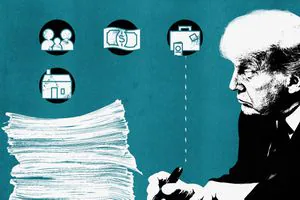
The Big, Beautiful, and Unapologetically Ugly: How Inequality Is Reinvented in America (And Why France Laughs at Us).
Posted in :
America’s latest economic bill may look shiny, but it widens gaps in wealth, showcases political back-scratching, and reminds us how much we could learn from countries like France (hello, five weeks paid vacation). Until citizens demand real change, the rich will keep playing with loaded dice.
The true face of America’s so-called “Big, Beautiful Bill,” exploring how new legislation cements an already lopsided wealth pyramid, all while comparing U.S. economic policies with those of France. It gets personal with the numbers, calls out political corruption, and asks what it would look like if the public demanded change the French way.
Picture this: It’s July 2025, and over iced coffee, I’m fuming about a headline. The Senate just passed what the news calls a “big, beautiful bill.” But as I watched the legislative horse-trading unfold, I couldn’t help thinking of my uncle’s old Chevy—pretty paint, engine full of holes. Let’s crack the hood on this bill, look at the raw numbers, and then—just to keep things spicy—see what France does when someone tries to take away their cheese (or their pensions). If you like your politics messy, grab a seat: it’s show-and-tell time.
Beneath the Chrome: The Real Shape of Wealth in 2025
Let’s peel back the shiny surface of the American economy in 2025 and look at what’s really going on underneath. The numbers are staggering, and honestly, a little hard to believe at first. But this is the reality: the bottom 50% of Americans—about 165 million people—together own just 2.5% of the nation’s wealth. That’s not a typo. Half the country is scraping by, sharing a tiny sliver of what’s out there, while the top 10% control nearly two-thirds of all wealth. If you’re looking for a snapshot of income inequality United States style, this is it.
Median household income hovers around $75,000 to $80,000. On paper, that doesn’t sound so bad. But dig a little deeper, and you see how these numbers hide the truth. In some cities, the gap between the highest and lowest earners is more than sevenfold. That’s not just a statistic—it’s a lived reality for millions. Wealth distribution statistics USA show a pyramid that’s grown steeper every year since World War II. The Gini Index, which measures inequality, confirms that the United States is now more unequal than Western Europe—a reversal from the postwar era.
And it’s not just about money; it’s about who gets left behind. Black workers, for example, still earn about 24% less than their white counterparts. The Black unemployment rate is roughly double that of whites as of early 2025. These aren’t just numbers—they’re reminders of the deep, persistent racial divides that shape economic life in America. Public opinion surveys show most Americans believe the system is rigged for the wealthy, and honestly, it’s hard to argue with them.
Let’s not forget the nearly 5% of the workforce made up of undocumented immigrants. These workers often fill the lowest wage jobs, propping up entire sectors of the economy while rarely sharing in its rewards. Their presence is another layer in the complex story of economic inequality 2025, and it’s a story that’s rarely told in full.
Here’s a quote that really hits home:
“You could never dream of a democracy—one person, one vote—if the top 10% control two-thirds of the wealth.” – Richard Wolff
What’s especially striking is how these divides are growing, not shrinking. Income inequality increase cities are easy to spot—just look at housing prices, school funding, or even who gets to retire comfortably. The “Big Beautiful Bill” passed in 2025, despite all the political fanfare, has only made things worse. Research shows that the real redistribution in America hasn’t been downward, as some fear, but upward—taking from the bottom and middle, and handing it to those already at the top.
So, beneath the chrome and the headlines, the real shape of wealth in 2025 is a pyramid that’s never been steeper. The numbers don’t lie, and neither do the lived experiences of everyday Americans. It’s not just about statistics—it’s about the kind of society we’re building, and who gets to share in its promise.
Corruption with a Smile: When Bills Buy the Rich (and Everyone Else Pays)
Let’s talk about the so-called “Big Beautiful Bill” that just passed the Senate. On paper, it’s sold as progress—something for everyone, a step forward for the American economy. But if you look a little closer, it’s clear this bill is built for the elite. This is corruption in American politics with a smile, where the real winners are the wealthy, and everyone else is left picking up the tab.
How does this happen? It’s all about horse-trading politics. Policy isn’t shaped by what’s best for the country or what’s fair for working families. Instead, it’s about who gets bought off with favors. Senators and representatives get their pet projects or special carve-outs in exchange for their votes. The result? A bill that’s packed with “goodies” for corporations and high-earners, while the rest of America gets little more than empty promises.
This isn’t new. The impact of Trump’s tax cuts in 2017 was just Act I. That bill slashed rates for top earners and corporations, giving a massive windfall to those who needed it least. Now, with the latest round of legislation in 2025, Act II is here—and it doubles down for the wealthy. Extensions and new provisions add even more tax advantages for the rich, making it clear who this bill is really for.
Richard Wolff put it bluntly:
“This will make inequality worse, just like his first tax cut for them did.”
The numbers back him up. The bottom half of Americans—about 165 million people—now own just 2.5% of the nation’s wealth. The next 40% (the so-called “middle”) hold about 30%. That leaves the top 10% with a staggering two-thirds of all wealth. So when new tax cuts and loopholes are handed out, it’s clear who benefits most.
Research shows that fiscal policy in the US continues to widen the gap. Tax relief, time and again, primarily benefits those already at the top. The “Big Beautiful Bill” is no exception. Instead of fixing inequality, it makes things worse. And this isn’t just a fluke—it’s a feature of how American politics works right now. Corruption in American politics is so normalized, it’s almost expected that bills are shaped by the interests of the wealthy and powerful, not by what’s best for the majority.
Meanwhile, public frustration grows. Studies indicate that most Americans believe the system is rigged in favor of the rich. They see the impact of Trump’s tax cuts and the new bill’s implications for the American economy: more wealth concentration, less opportunity, and a growing sense that the rules are written for someone else.
In the end, the culture of horse-trading and backroom deals means tax cuts and inequality go hand in hand. The “Big Beautiful Bill” is just the latest example of how policy is bought, not earned—and how everyone else pays the price.
Why The French Laugh (and March): Lessons from Across the Atlantic
When it comes to US France economic policies, the differences aren’t just numbers on a spreadsheet—they’re lived realities. In France, the idea of workers’ rights and public welfare is woven into the fabric of daily life. And when lawmakers try to unravel those threads, the French don’t just grumble. They march. They strike. They make noise until the government listens.
Take, for example, what happened when French lawmakers tried to chip away at worker benefits. Half the country hit the streets. Unions, left-wing parties, and everyday citizens banded together in a show of organized resistance that ultimately killed the bills. This is not just a one-off event; it’s a pattern. The public response to economic inequality in France is powerful and immediate, thanks to strong social movements and a political culture that expects leaders to answer to the people.
Contrast that with the United States. Here, the public response is, well, quieter. Despite rising inequality—where the bottom half of Americans own just 2.5% of the nation’s wealth, and the top 10% control nearly two-thirds—mass mobilization is rare. The party system is weaker, and social movements, while present, don’t have the same force or frequency. As a result, policies that favor the wealthy often pass with little more than a collective sigh.
Let’s dig into the comparison: US France economic policies. In France, every worker is guaranteed at least five weeks of paid vacation. That’s not a fantasy, it’s the law. As economist Richard Wolff puts it:
“In France, once you finish school and get a job, the law requires your employer to give you five weeks paid vacation every year.”
Healthcare? Covered from birth to death. No one worries about losing coverage if they lose their job. Higher education? Tuition is free, or nearly so. Students pay for room and board, but not for the privilege of learning. There’s no mountain of debt waiting at graduation.
Meanwhile, in the U.S., healthcare and education policies are a different story. Medical care is often tied to your job. Lose your job, lose your coverage. College? For most, it means taking on debt that can follow you for decades—unless you’re wealthy, of course. The safety net is thin, and getting thinner.
This isn’t just about comfort or convenience. It’s about priorities. France has chosen to prioritize public welfare, using robust social policies to keep inequality in check. The U.S., on the other hand, has seen wealth redistribution move upward, concentrating more and more resources at the top. Studies indicate that these choices have real consequences: France’s approach has helped mitigate inequality, while in the U.S., the gap keeps growing.
So, why do the French laugh—and march—when they look across the Atlantic? Because they see a system where the people at the top keep taking more, while the rest are told to be grateful for scraps. And they know, from experience, that it doesn’t have to be this way.
Tying It All Together: Will the Spectator Majority Ever Storm the Field?
If there’s one lesson history keeps teaching us, it’s this: when inequality grows too extreme and governments keep ignoring the masses, eventually the pitchforks come out. The story of wealth redistribution upward in America isn’t just about numbers—it’s about the slow unraveling of social trust and the myth that anyone can make it if they just work hard enough. Today, that American myth of meritocracy is being tested like never before.
Let’s be honest: the effects of wealth redistribution upward are everywhere. The latest “big, beautiful” bill, as Richard Wolff points out, is just another chapter in a long story where the richest Americans take a bigger slice of the pie, while the rest are left with crumbs. Half of Americans now share just 2.5% of the nation’s wealth. The next 40%—the so-called “middle”—get about 30%. That leaves the top 10% controlling the lion’s share. It’s a system that, as Wolff bluntly puts it, turns most of us into spectators, watching as the top 10% play a game rigged in their favor.
Public opinion on income inequality is reaching a boiling point. Research shows that most Americans now believe the economic system is rigged for the wealthy. But here’s the catch: while discontent is rising, the public response to economic inequality in the U.S. remains muted. Unlike France, where citizens have taken to the streets—sometimes by the millions—Americans are still mostly on the sidelines. In France, attempts to push through policies that would increase inequality have been met with immediate, organized resistance. People mobilize, unions and left-wing parties lead the charge, and the government is forced to listen.
So, what’s holding Americans back? Maybe it’s the persistent belief that the system will eventually reward hard work. Maybe it’s the lack of political alternatives, with both major parties deeply influenced by wealthy donors. Or maybe it’s just the sheer exhaustion of trying to keep up in a system that feels stacked against you. Whatever the reason, the consequences of this inaction are real. The effects of wealth redistribution upward don’t just threaten individual livelihoods—they threaten the very fabric of democracy.
As Wolff warns, “We are watching what happens when that crucial moment is arrived at… It’s not sustainable what we are doing in this country.” If the status quo continues, the risks are clear: elite control could spark severe backlash, or worse, lead to social collapse. The question is whether Americans will remain bystanders—or whether, inspired by the French example, they’ll finally decide to storm the field.
In the end, moving beyond outrage is the only way forward. Real change—whether it’s fairer tax policies, universal healthcare, or free college—won’t come from the top. It will come when the majority stops spectating and starts demanding a new economic story. Until then, the rest of the world, especially France, might just keep laughing at how we let inequality reinvent itself, again and again.
TL;DR: America’s latest economic bill may look shiny, but it widens gaps in wealth, showcases political back-scratching, and reminds us how much we could learn from countries like France (hello, five weeks paid vacation). Until citizens demand real change, the rich will keep playing with loaded dice.
IncomeInequalityUnitedStates, EconomicInequality2025, WealthDistributionStatisticsUSA, ImpactOfTrump’sTaxCuts, CorruptionInAmericanPolitics, USFranceEconomicPolicies, WealthRedistributionUpward, HealthcareEducationPoliciesFranceUSA, BigBeautifulBillImplicationsAmericanEconomy,Trump’staxcuts, incomeinequalityUnited States, economicinequality2025, USFranceeconomicpolicies
#IncomeInequality, #USPolitics, #WealthGap, #TaxCutsDebate, #EconomicJustice, #PolicyComparison, #HealthcareInequality, #EducationReform, #FightCorruption, #InequalityMatters,#economicinequality, #wealthredistribution, #trumptaxcuts, #fiscalpolicy, #richardwolff, #americanpolitics, #francevsusa, #incomeinequality

